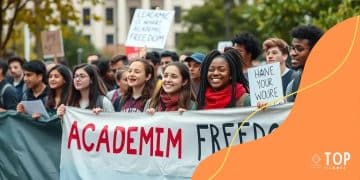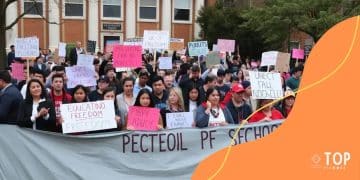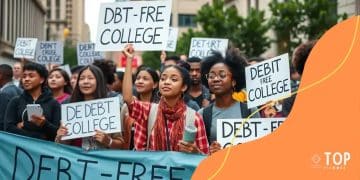Student protests for academic freedom: voices rise up
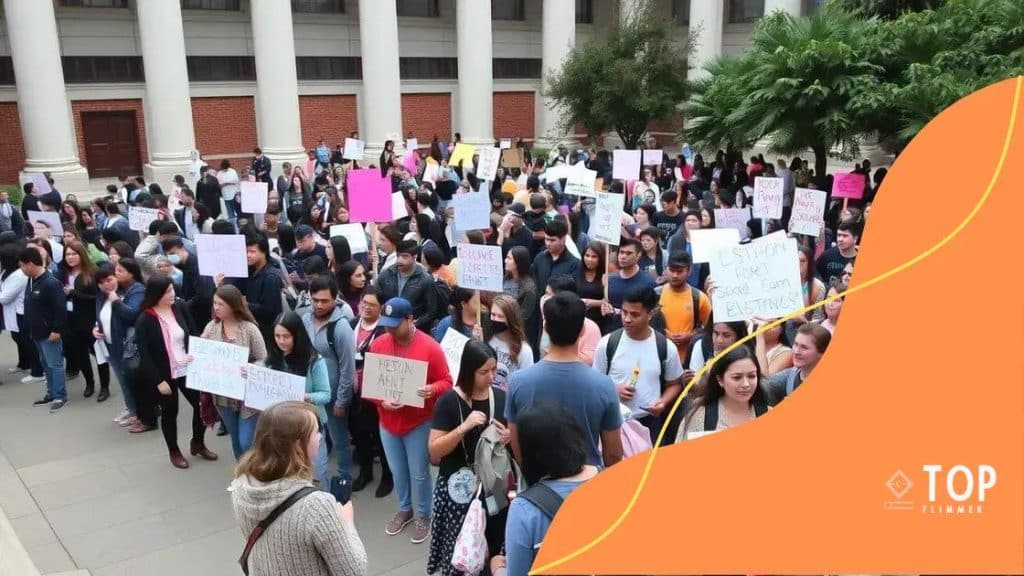
Student protests for academic freedom highlight critical issues like social justice, affordability, and mental health support, prompting institutions to engage thoughtfully and revise policies to foster a more equitable educational environment.
Student protests for academic freedom have become a powerful symbol of the fight for educational rights. With voices rising across campuses, these movements challenge traditional boundaries and spark critical conversations. Wondering what’s at stake? Let’s dive in.
The significance of academic freedom
Academic freedom is a vital aspect of higher education, promoting an environment where ideas can be explored without fear. It ensures that students and educators can engage in open discussions that challenge the status quo.
Understanding Academic Freedom
When we talk about academic freedom, we refer to the freedom of teachers, students, and academic institutions to pursue knowledge and research openly. This freedom is crucial for fostering innovation and critical thinking.
Key Benefits of Academic Freedom
- Encourages creativity and individual expression.
- Supports a diverse range of perspectives and ideas.
- Facilitates rigorous debate that enhances learning.
- Protects the rights of students and faculty to speak out against injustice.
Moreover, academic freedom is not just beneficial for individuals; it also enriches the academic community. When students feel safe to voice their opinions, it leads to a more inclusive and comprehensive educational experience.
However, the significance of academic freedom goes beyond the classroom. It plays a crucial role in societal development. A society that values academic freedom is likely to promote democratic values and human rights.
As we see more student protests advocating for academic freedom, it becomes clear that the future of education depends on fostering an atmosphere of liberation and inquiry.
Historical overview of student protests
Student protests have shaped educational institutions and societies throughout history. By engaging in activism, students have challenged norms and advocated for academic freedom and social justice.
Early Examples of Student Protests
One of the earliest notable student protests occurred in the 1960s during the civil rights movement. Students were pivotal in fighting against segregation and calling for equality. This activism set the stage for future movements, highlighting the power of youth voices.
Global Movements
Over the decades, student protests have emerged globally, addressing issues such as government policies, war, and educational reform. For instance, in 1968, protests erupted in Paris, where students united with workers to demand political change. This event emphasized the role of students as catalysts for broader societal shifts.
- Protests against the Vietnam War united students in the United States.
- The Tiananmen Square protests in Beijing showcased the fight for democracy.
- In India, student movements have protested against educational inequality.
In recent years, movements like the March for Our Lives and climate strikes have highlighted how students continue to take a stand on pressing issues. This evolution illustrates that student protests remain relevant.
As history shows, the importance of students voicing their concerns cannot be overstated. These protests signify a desire for change and a commitment to shaping the future.
Key issues driving current demonstrations
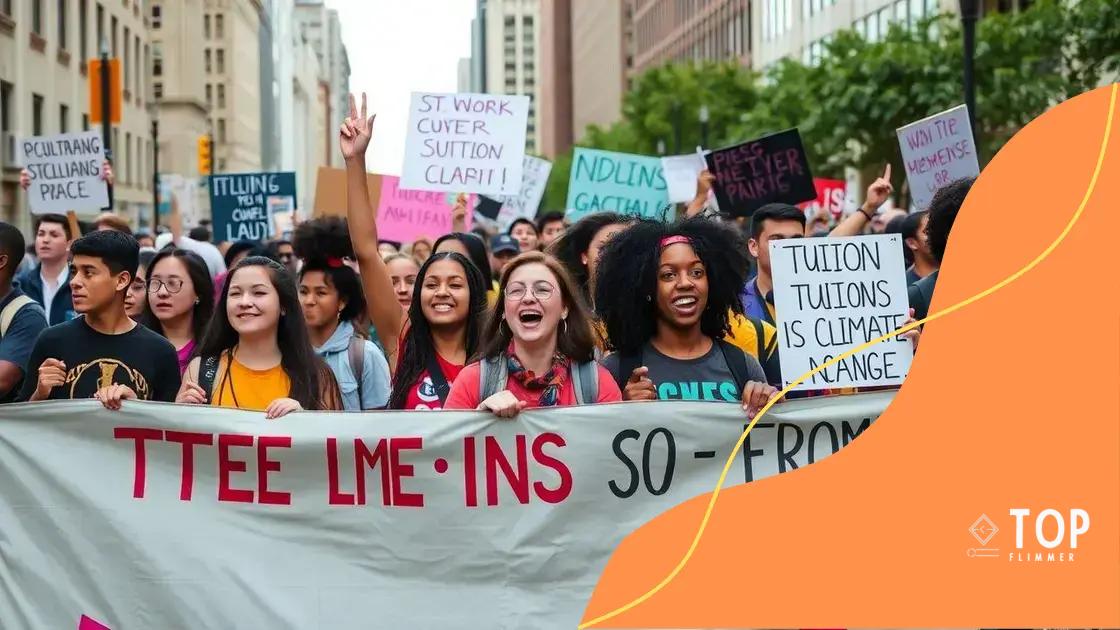
Current demonstrations led by students are often fueled by significant issues that resonate deeply within society. These challenges highlight the need for change and reform in various areas of education and governance.
Social Justice and Equality
A major focus of recent protests is social justice. Students are advocating for equal treatment and opportunities for all, regardless of background. They believe that education should be accessible and equitable.
Tuition Costs and Student Debt
Another crucial issue is the rising cost of education. Many students face overwhelming debt after graduation. Activists are demanding reforms to lower tuition and make college more affordable.
- Calls for tuition-free community college.
- Advocacy for increased financial aid.
- Proposals for cancelling student debt.
Environmental concerns are also prominent in student protests today. Young activists are raising awareness about climate change, urging institutions to adopt sustainable practices. They are determined to hold both universities and governments accountable for their role in environmental degradation.
Furthermore, issues such as mental health resources and campus safety are vital topics. Students expect their schools to provide robust support systems that address their well-being. This demand reflects a shift in how mental health is viewed within educational contexts.
As we see students mobilizing for these key issues, it becomes evident that their activism is not just about education; it represents a broader call for societal change.
Impact of social media on student activism
Social media has transformed how students engage in activism. Platforms like Twitter, Instagram, and TikTok allow young people to connect, organize, and mobilize quickly.
The Power of Connectivity
With a simple post or tweet, students can share their messages with a global audience. This wide reach amplifies important issues, allowing student activism to gain traction far beyond campus boundaries.
Real-Time Organization
Social media enables real-time organization of events, making it easier for students to gather for protests and rallies. They can quickly share updates, meeting locations, and resources. This immediacy enhances participation during critical moments.
- Creating hashtags to promote events.
- Using live streaming to document protests.
- Encouraging others to share their experiences.
Moreover, students are increasingly using social media to raise awareness about issues affecting their communities. Campaigns promoting academic freedom and social justice are often launched online, and they gain momentum through shares and likes.
The visual nature of platforms like Instagram helps convey powerful messages. Images and videos can evoke emotions, inspiring action and solidarity among viewers. A compelling photo can drive home the urgency of a cause, making it relatable.
While social media offers many advantages, it also poses challenges. Misinformation can spread rapidly, and online harassment is a real issue. Students must navigate these risks while harnessing social media’s potential.
How institutions are responding to protests
As student protests grow more frequent, educational institutions are facing pressure to respond. The way schools handle these protests can greatly impact their reputation and relationship with students.
Engagement with Students
Many institutions recognize the importance of engaging with students during protests. Instead of ignoring concerns, they are increasingly willing to listen and facilitate open dialogues. This approach helps build trust and shows students that their voices matter.
Policy Revisions
In response to protests, some institutions are revising their policies. These changes may involve enhancing campus safety measures or creating more opportunities for student involvement in decision-making. By taking action, schools demonstrate their commitment to addressing the issues raised by students.
- Introduction of transparency policies regarding funding.
- Creation of task forces focused on student concerns.
- Implementation of programs that promote diversity and inclusion.
Moreover, institutions are leveraging social media as a tool for communication. By using platforms like Twitter and Instagram, schools can share their responses to ongoing protests quickly and effectively. This real-time engagement can help counter negative narratives and show support for student causes.
Yet, some institutions react defensively. This approach might involve crackdowns on protests or disciplinary actions against protesting students. Such responses can lead to further unrest and damage the institution’s reputation.
Overall, how institutions decide to engage or respond reflects their values and commitment to student welfare. Understanding this dynamic is essential as student activism continues to evolve.
In conclusion, student protests for academic freedom are vital to shaping the future of education. They highlight key issues such as social justice, affordability of education, and mental health support. Educational institutions must respond thoughtfully to these movements, as their actions will define their relationship with students and impact their reputations. Social media plays a crucial role in amplifying student voices, allowing for connection and mobilization across campuses. As activism continues to evolve, the importance of listening and engaging with student concerns will only grow. Together, students and institutions can foster an environment that promotes equity, understanding, and progress.
FAQ – Frequently Asked Questions about Student Protests for Academic Freedom
What are the main issues driving student protests?
The main issues include social justice, affordability of education, mental health resources, and calls for greater academic freedom.
How does social media impact student activism?
Social media allows students to connect, mobilize quickly, and amplify their messages, making it easier to organize protests and spread awareness.
How are educational institutions responding to these protests?
Institutions are engaging with students, revising policies, and using social media for communication to address concerns raised during protests.
What role do students play in shaping educational policies?
Students play a crucial role by advocating for their rights, voicing concerns, and influencing policy changes to create a more equitable educational environment.

